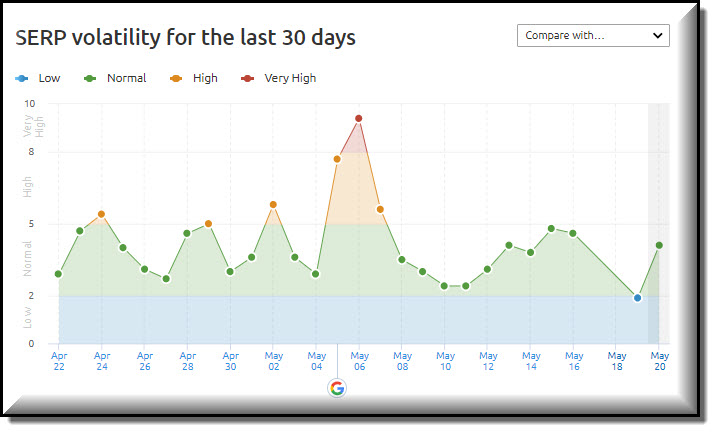Google has confirmed its latest Core Update, known as the May 2020 Core Update, has now been fully rolled out, and I know many marketers are concerned their websites may have felt the impact of the change, either positively or negatively.
The May 2020 Core Update is now rolling out live. As is typical with these updates, it will typically take about one to two weeks to fully roll out.
— Google SearchLiaison (@searchliaison) May 4, 2020
What is a Core Update?
Google is constantly tweaking its algorithm which are the rules it uses to determine ranking positions in the search results. There isn’t any fanfare or announcement, just small incremental changes that it makes to improve the search results.
And then Google makes substantial changes to its algorithm every few months or so. The goal is to ensure the most relevant and useful websites rank well in the search results. These broad, significant changes are referred to as Core Updates, and in these instances Google will make a public announcement because there are usually notable effects as a result of these changes.
In this article, Google’s Public Liaison Danny Sullivan explains the principle of Core Updates.
And since the last update was in January, there is no great surprise that Google rolled out another Core Update in May.
Once upon a time core updates were given witty names like Panda, or Penguin. This update took place on 4 May… so the wags wanted to name it the “May the Forth Be With You” update, but Google has clamped down on that by providing its own naming convention, sticking to the date launched.
So what changed in the Google May 2020 Core update?
Google doesn’t reveal the specific changes it has made in the update, so search professionals monitor the ripple effects and then try to reverse engineer (or guess) what the changes comprised.
There are a number of reliable sources that are interpreting the May Core Update.
SEMRush produce a SERP Volatility Sensor, that tracks the changes of rankings in the SERPs (Search Engine Results Pages). The spike corresponding to the Core Update is easy to see:

Marie Haynes has written an excellent overview of the May Core Update, and according to her detailed research, the update is aiming to gain a better understanding of what the searcher is looking for and then to present in the search results the most helpful results.
You might think this has been Google’s goal all along, and you wouldn’t be wrong.
But Google is always getting better at figuring out searcher intent, and providing the most relevant search results. According to Marie’s analysis, the substantial changes in the Core Update probably included some of the following:
- Getting a better understanding of what the searcher is trying to find. The first step in producing a set of search results is to establish what it is you’re looking for. And we all know that the new generation of searchers are behaving differently when it comes to searching. Rather than just putting in one or two keywords, the new generation of searchers types in a full question. Last year Google introduced BERT to help with natural language processing for searches of a conversational or complex nature. And perhaps this update is the next step in the evolution.
- Getting a better understanding of how trustworthy your website is: Expertise, Authority, and Trustworthiness. Google has previously confirmed your E-A-T (Expertise, Authority and Trustworthiness) is a ranking signal. Indeed, Google’s Search Quality Evaluator’s Guidelines are used by humans to evaluate websites and the resulting search results pages. There has been significant movement in sites that are sticking to Google’s guidelines outlined in its Core Update guidance.
- Link quality. Inbound linking has always been a powerful signal when it comes to ranking website. This Core Update might be ignoring links that are clearly self-made mentions or links made purely for SEO purposes, and giving greater credence to links that are genuine recommendations for genuinely useful or fabulous content. If you want to brush up on your knowledge of link building, take a look at our guide to what makes a link bad, and more importantly our guide to perfect inbound links: 21 signs a link is great.
How do you know if your site has felt the impact of a Google Core Update?
There are two quick ways you can evaluate if you’ve been impacted.
The first step is to use tools to measure your current rankings. My personal favourite is SEMRush to check your current rankings for keywords. And Neil Patel makes available the free Ubersuggest tool that let’s you track up to 25 keywords. You’re going to be looking to see if there have been any winners or losers for your key phrases, and in additions to rankings you will want to keep an eye on featured snippets (take a look at our guide). As an example, here is a screen grab from SEMRush for our own website, showing the leap in visibility for one of our target phrases as compared to one of our competitors, arising immediately following the update:

And the next thing you need to do is take a look at your Google Analytics to see if you have experienced a change in your organic traffic since the 4 May launch of this core update. Here is a handy guide to getting started with Analytics if this is new to you.
And you might be looking for visual clues like this:

What do I need to do if I think I’m losing rankings and traffic?
First of all, there is no guarantee that you will be impacted by this Core Update, either positively or negatively. There is a very good chance, and indeed Google recommends, you do not need to take any action at all.
If you have lost traffic, then keep in mind Core Updates tend to happen every few months. If you make improvements to your content, your site might still not recover until the next update is released.
Google has shared a series of questions for you to use to review on your website. These recommendations are related to creating a better user experience, and that should be the golden thread running through your SEO strategy.
Fundamentally, these questions are not new (the current version dates back to the core updates guidance dating back to 2019) but the principles are still true.
Content and quality questions
- Does the content provide original information, reporting, research or analysis?
- Does the content provide a substantial, complete or comprehensive description of the topic?
- Does the content provide insightful analysis or interesting information that is beyond obvious?
- If the content draws on other sources, does it avoid simply copying or rewriting those sources and instead provide substantial additional value and originality?
- Does the headline and/or page title provide a descriptive, helpful summary of the content?
- Does the headline and/or page title avoid being exaggerating or shocking in nature?
- Is this the sort of page you’d want to bookmark, share with a friend, or recommend?
- Would you expect to see this content in or referenced by a printed magazine, encyclopedia or book?
Expertise questions
- Does the content present information in a way that makes you want to trust it, such as clear sourcing, evidence of the expertise involved, background about the author or the site that publishes it, such as through links to an author page or a site’s About page?
- If you researched the site producing the content, would you come away with an impression that it is well-trusted or widely-recognised as an authority on its topic?
- Is this content written by an expert or enthusiast who demonstrably knows the topic well?
- Is the content free from easily-verified factual errors?
- Would you feel comfortable trusting this content for issues relating to your money or your life?
Presentation and production questions
- Is the content free from spelling or stylistic issues?
- Was the content produced well, or does it appear sloppy or hastily produced?
- Is the content mass-produced by or outsourced to a large number of creators, or spread across a large network of sites, so that individual pages or sites don’t get as much attention or care?
- Does the content have an excessive amount of ads that distract from or interfere with the main content?
- Does content display well for mobile devices when viewed on them?
Comparative questions.
- Does the content provide substantial value when compared to other pages in search results?
- Does the content seem to be serving the genuine interests of visitors to the site or does it seem to exist solely by someone attempting to guess what might rank well in search engines?
Link quality
If you have experienced a drop in traffic, then you may also want to be reviewing your link building strategy. Take a look at our guide What makes a “bad link” when link building for SEO.
Have you found this post useful?
Get our free ebook "The future of digital marketing"
Dive into our ebook to learn more about the technologies and strategies that will have the greatest impact on digital marketing and how you can apply these to your business today. Build your knowledge of top-of-mind trends and get an in depth overview of trends in SEO, analytics, digital PR and PPC.


